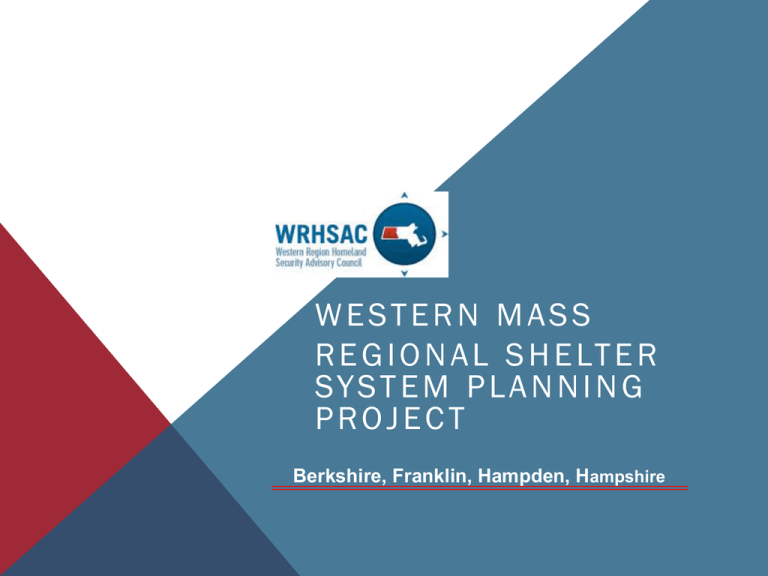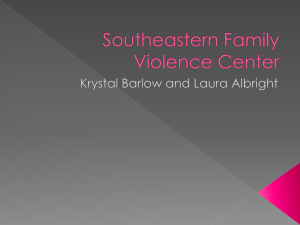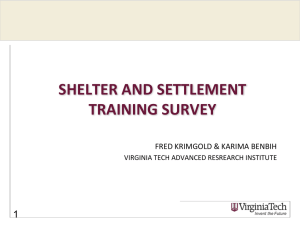COAD_2014_Shelter_Presentation_3-14-14_sm
advertisement

WESTERN MASS R E G I O N A L S H E LT E R SYSTEM PLANNING PROJECT Berkshire, Franklin, Hampden, Hampshire PROJECT GOALS Provide templates and tools Educate about best practices Improve local capabilities Promote regional systems and plans Provide and manage regional supplies Train and exercise plans CHALLENGES Shelters are small villages – very complex Regional Command and Control Local buy-in Regional funding mechanisms Sufficient numbers of trained staff Resource gaps Integration with State Shelter Plan GUIDING PRINCIPLES National best practices Detailed information Scalable ICS structure Functional Needs Support Services Risk Communication Public health and safety concerns Animal sheltering (separate plan) TOOLKIT COMPONENTS Concept of Operations – the “Plan” Shelter assessments and maps MOUs and agreements Lists of suggested vendors for supplies Policies and procedures Standard Operating Guidelines (SOG) Job Action Sheets (JAS) based on ICS Shelter Forms and Resource Lists CONCEPT OF OPERATIONS Intended for pre-incident planning Guides the planning process Identifies possible shelter locations Encourages pre-planned written agreements Provides “triggers” for activation Annex to the Comprehensive Emergency Management Plan (CEMP) ICS ORGANIZATION CHART (LARGE SHELTER) KEEPING EVERYONE ON TRACK THE INCIDENT COMMAND SYSTEM Incident Commander and Shelter Manager Takes overall responsibility Safety Officer Keeps responders and shelter clients safe Liaison Officer Works with partners Public Information Officer Shares information with the public and clients Operations Runs human or animal shelter Logistics Get staff/volunteers, supplies , equipment and transportation Planning Determines next steps Finance Arranges payments; tracks data SOME SPECIALTY POSITIONS IN SHELTERS Medical Advisor A physician to help guide medical practices Functional Needs Advisor Ensures that the shelter works for everyone Ombudsman Addresses conflicts/issues Animal Manager Addresses needs of pets; service animals Case Management Helps clients getting back to normal with required services Donations Management Collects and organizes donated goods and services SHELTER OPERATIONS Dormitory Unit Organizes sleeping and living arrangements Childcare Unit Meets needs of children Registration Keeps track of everyone Medical Team Supports medical needs Behavioral Health Unit Addresses client/staff stress JOB ACTION SHEETS (JAS) Every major position in the shelter has a JAS Who they report to and who reports to them Where to get help/resources Responsibilities Initial planning actions Initial response Daily operations Shelter closing FORMS Forms help with accountability Listed on the Job Action Sheets for all positions Used to document everything reports, actions, problems, requests, agreements, information, complaints, etc. STANDARD OPERATING GUIDE (SOG) SOGs are checklists The SOG is not prescriptive These are tasks to consider In an emergency, you don’t have time to remember everything. Use the SOG! REGIONAL SHELTER SOG Sheltering Objective To determine and meet public health and safety jurisdictional roles and responsibilities and ensure partner agencies are able to address the public health, medical, behavioral health, safety and sheltering needs of individuals at a congregate location Quick Overview Shelters are like mini villages, often populated by individuals with varying functional needs, especially cultural, health and animal needs. Shelter Managers skip to Operations for Shelter Site Assessment/Personnel Safety Safe Food, Water, Housing Shelter Volunteers/Logistics Communications Medical/Behavioral Health Case Management Functional Needs Support Services (FNSS) Service Animals/Pets Resource/Donation Management 1. Initial Response Actions Begin Within Initial Assessment of the Event 0 - 3 hours Contact relevant Response Partners .25 – 1 hour Establish Command and Control .50 – 2 hours Initiate Risk Communications and Emergency Public Information /Warning 1 – 3 hours Review Emergency Plans, Policies and Procedures 2 – 4 hours 2. Operations Confirm Incident Command Roles Begin Within 1 - ongoing Complete Shelter Facility Walk-through/Assessment 2 - ongoing Determine/Request Shelter Logistical Needs and Resources, 3 - ongoing Complete Shelter Set-up and Open 3 - ongoing Establish Volunteer Management Systems/Policies 4 - ongoing Meet Transportation Needs 4- ongoing Monitor Operations Health, Safety , Functional Needs, Case Management 5 - ongoing Plan for Next Operational Period and Shelter Closing 6 - ongoing 3 Recovery Begin Within Case Management new normal transition - home, temporary housing, long-term care ongoing Lift Orders and assist with shelter cleaning and closing as appropriate Support recovery and return to normal operations ongoing Submit Forms and complete After Action Report and Improvement Plan 30 days APRIL BLIZZARD SNOWPRIL 2014 Heavy, wet snow has been falling at the rate of 2 inches per hour for more than 12 hours. The wind is fierce and power lines are down everywhere. Travel is difficult. People are cold and hungry. The elderly are desperate for help. You get a call to open a shelter. What do you do? WHAT ARE YOUR FIRST STEPS? Stay calm, you have a plan… Make sure your family is OK… Get your personal “Go Kit” ready…. Review your plans and the shelter SOG… SOG INITIAL RESPONSE ACTIONS Look at the First Page of your Shelter SOG 1. Assess the Situation – what is happening? 2. Contact Partners – call everyone, including your EMD and/or COAD partners 3. Command and Control. Who is doing what? Think about ICS. 4. Public Information should begin 5. Read your plans! WHAT IS YOUR ROLE? WHAT ARE YOU DOING? EMD? COAD? MRC/DART/CERT? Public Health? Hospitals/EMS? First Responders? ARE YOU IN CHARGE OF THE SHELTER? Name 6 things you should be doing or considering? 1. 2. 3. 4. 5. 6. HERE ARE MY 6 THINGS 1. Where is my shelter? Has it been assessed? 2. What are the Shelter Polices? (look in the plan and adjust based on the current situation) 3. Do I have the right/enough stuff/volunteers? COAD/MRC/CERT/ARC 4. Can the shelter serve everyone? FNSS? 5. How am I handling spontaneous volunteers? 6. How is everyone getting to the shelter? ARE YOU SUPPORTING THE SHELTER? Name 6 things you should be doing or considering? 1. 2. 3. 4. 5. 6. MY COAD CHECKLIST 1. Is my organization prepared to help? 2. Am I prepared to help? How Can We Help? serve our clientele so they can stay home provide resources (people, equipment, supplies)? Can I donate them? Do I need to be paid? …MORE COAD “TO DOS” 1. Am I in contact with my COAD and/or EMD? 2. Am I tracking all my resources, including time & materials? 3. Other? 4. How can I stay informed! WHAT NOT TO DO? 1. Don’t self-deploy 2. Don’t talk to the media on behalf of someone else – unless authorized by the IC or your organization 3. Don’t wait to be asked or make contact. If you have something to offer, contact your COAD or the EMD 4. Don’t wait to ask for help! SHELTER OPERATIONS IS JUST 1, 2, 3… 1. Follow the Shelter SOG checklist. Adjust as needed. 2. Use the Job Action Sheets for each position on the ICS Chart. Modify as needed. 3. Use the Forms mentioned in the JAS to document everything. 3 MORE STEPS FOR OPERATING SHELTERS 1. Consider Functional Needs Support Services (FNSS) 2. Maintain communications 3. Take care of yourself first! EXERCISE YOUR PLAN AND SKILLS Everything is easier if you have practiced Participate shelter exercises– UMass Apr 10/11 Exercise your own plan Take the WRHSAC on-line shelter training- May Attend a Red Cross shelter training Become an MRC/COAD/ARC/CERT volunteer Become an Emergency Rest Center (ERC) QUESTIONS TODAY? 1. What do you want to ask your partners? 2. COADS, what are your questions for EMDs? 3. EMDs, what are your questions for COADs? PROJECT STATUS Complete Shelter template Shelter assessments, maps in Hampshire Regional shelter supplies - WRHSAC Ongoing Regional Concept of Operations planning List of suggested vendors with MOUs SHELTER PLANNING NEXT STEPS Explore inter-municipal agreement (IMA) Develop funding mechanisms Establish and train Shelter Staffing Teams Complete regional plans Continue to integrate COAD/MRC/ARC/CERT into local and regional plans Use After Action Reports to improve plans ONLINE INTERACTIVE SHELTER TRAINING Goals of Project • Companion Training to the Regional Shelter Planning toolkit • Build shelter operations awareness/proficiency for shelter personnel • Establish strong building block for future steps of project, ie exercises • Online modules provide sustainability of training EXAMPLE TRAINING MODULE STAFF / VOLUNTEER CERTIFICATION Online training offers • Flexibility • Certification • Just in Time Training • Can be used in drills and exercises Anticipated Launch Date: End of May – early June 2014 COMING IMPROVEMENTS WRHSAC Projects COADs and Faith Community Integration with State Shelter/Evacuation Plans Medical protocols Evacuation Service Centers Emergency Rest Centers Regional MACC/REOC WHAT SHOULD I BE DOING NOW? 1. Have your own family/personal emergency plan 2. Make sure your organization has an emergency plan 3. Educate your constituents and clients 4. Make sure your town has a shelter plan. Modify the template to meet your needs Add local information. RESOURCES AND MORE INFORMATION See WRHSAC and other website for Western Mass and State shelter & Volunteer Management Plans www.wrhsac.org wrhsac.org/projects-and-initiatives/shelterevacuation/ www.wmmrc.org ACKNOWLEDGEMENTS Financial Support from WRHSAC Members of the HREPC Planning Committee Staff Support from Planning Commissions and Public Health Coalitions Subject Matter Support MEMA-EMDs/DPH-Local Public Health Medical Reserve Corps/HEART/DART American Red Cross Schools







